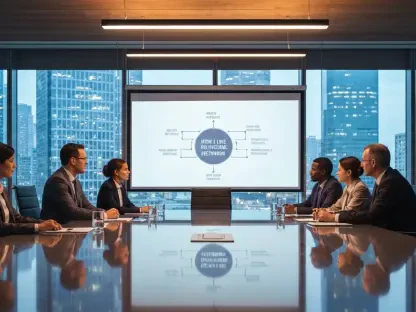Imagine a financial landscape where payments companies can sidestep traditional banking intermediaries, gain direct access to credit card networks, and potentially slash operational costs by leveraging innovative regulatory frameworks. This isn’t a distant dream but a reality unfolding in Georgia with the Merchant Acquirer Limited Purpose Bank (MALPB) charter. This unique banking credential has sparked a rush among fintech giants and emerging players alike, promising to reshape the dynamics of transaction processing. The purpose of this roundup is to dive into diverse perspectives from industry stakeholders, uncover the strategic allure of the MALPB charter, compare varying opinions on its potential, and explore why Georgia has become a hotbed for payments innovation.
Unpacking the Surge: What’s Driving Interest in Georgia’s Banking Credential?
Industry Voices on the Charter’s Transformative Potential
Across the payments sector, there’s a growing consensus that the MALPB charter represents a game-changing opportunity for firms seeking greater control over transaction settlement. Many industry leaders highlight how this credential allows companies to directly interact with credit card networks, reducing reliance on partner banks. This autonomy is seen as a critical step toward streamlining operations in an increasingly competitive fintech environment, where every efficiency gain can translate into a market edge.
Differing views emerge on the pace of adoption, however. Some insiders argue that the charter’s appeal lies in its immediacy, noting that major players have already secured conditional approvals in recent months. Others caution that while the concept is promising, the practical challenges of implementation—such as gaining full network acceptance—could temper enthusiasm for smaller firms lacking the resources of industry giants.
Georgia as a Fintech Hub: A Regional Perspective
Another angle of discussion centers on why Georgia, specifically, has become the epicenter of this trend. Stakeholders point to the state’s proactive regulatory framework and supportive business climate as key factors drawing payments firms. The Department of Banking and Finance has been vocal about ongoing interest, with multiple applications in the pipeline, reinforcing Georgia’s reputation as a fintech-friendly destination.
Contrasting opinions surface regarding scalability beyond state borders. While some believe Georgia’s model could inspire similar charters in other regions, others question whether the unique combination of regulatory flexibility and local expertise can be easily replicated. This debate underscores the charter’s regional significance while hinting at broader national implications for fintech policy.
Strategic Insights: Benefits and Challenges of the MALPB Charter
Direct Network Access: A Game-Changer for Payments Firms
One of the most discussed benefits of the MALPB charter is the ability to connect directly with credit card networks, a point of agreement among many industry observers. This direct line is viewed as a strategic advantage, enabling firms to settle transactions without intermediary banks, thus enhancing speed and control. The potential to act as sponsor banks themselves adds another layer of operational independence.
However, not all perspectives align on the ease of achieving this access. Some industry watchers recall historical resistance from card networks toward non-traditional players, suggesting that even with the charter, securing partnerships remains a hurdle. Others remain optimistic, pointing to the evolving attitudes of networks as larger, more established firms enter the fray with greater negotiating power.
Cost Savings and Competitive Pricing: A Double-Edged Sword
Cost efficiency emerges as a central motivator in discussions about the charter’s appeal. Many experts note that bypassing traditional banking partners can significantly reduce operational expenses, allowing firms to either lower processing fees for merchants or bolster their own margins. This financial incentive is often cited as a driving force behind the recent wave of applications.
Yet, there’s a counterpoint on the risks tied to this strategy. Some voices in the sector warn that over-reliance on cost-cutting could strain relationships with card networks or compromise service quality. Balancing competitive pricing with sustainable operations is seen as a delicate act, with differing opinions on whether smaller applicants can manage this as effectively as industry heavyweights.
Historical Lessons: Past Failures and Current Optimism
Reflecting on history, many stakeholders bring up early attempts to leverage the MALPB charter, where initial applicants faced rejection from credit card networks and ultimately abandoned their efforts. This cautionary tale is frequently mentioned as a reminder of the charter’s complexities, with some arguing that past failures highlight the importance of network buy-in for success.
On the flip side, there’s a wave of optimism about the current landscape. Observers note that today’s applicants, often larger and more influential, are better positioned to navigate these challenges. The contrast between past struggles and present confidence fuels a nuanced debate on whether the industry has truly turned a corner or if unseen obstacles still loom.
Future Trends: What’s Next for Applicants and the Industry?
Rising Interest and Potential Regulatory Shifts
The accelerating interest in the MALPB charter is a hot topic, with state officials confirming a steady stream of applicants and expressions of intent. Many in the industry see this as a signal of a broader trend toward financial autonomy, where payments firms increasingly seek to redefine their roles outside traditional banking structures. Georgia’s growing list of interested parties is often cited as evidence of the charter’s enduring allure.
Speculation abounds on whether this momentum could prompt regulatory evolution elsewhere. Some suggest that other states might develop comparable credentials to attract fintech investment, while others argue that Georgia’s unique position may remain unmatched for years. This split in thought reflects uncertainty about the charter’s long-term impact on national policy.
Sustainability Concerns: Can Success Be Guaranteed?
Despite the excitement, there’s a sober discussion about the charter’s sustainability. Many point out that while the credential offers clear advantages, it doesn’t automatically ensure market success, especially given historical precedents of failure. The need for robust strategies to handle regulatory scrutiny and network dynamics is a recurring theme in these conversations.
Contrasting views emerge on the longevity of this trend. Some believe the charter could fundamentally alter the payments landscape if more firms succeed, while others question whether rapid changes in technology and competition might outpace the benefits. This ongoing dialogue keeps the focus on adaptability as a key factor for future applicants.
Key Takeaways from the Roundup Discussion
Looking back, the roundup revealed a rich tapestry of insights on Georgia’s MALPB charter, with industry perspectives converging on its potential to transform payment processing through direct network access and cost efficiencies. Divergent opinions on challenges like network acceptance and competitive pressures painted a balanced picture of opportunity and risk. Historical lessons juxtaposed with current optimism underscored how far the sector has come, while discussions on future trends highlighted Georgia’s pivotal role in fintech innovation.
For payments firms and stakeholders, the next steps involve strategic planning, from securing card network partnerships to navigating regulatory landscapes with expert guidance. Monitoring Georgia’s evolving policies and exploring collaborative models with established players emerged as practical considerations. Beyond immediate actions, the broader question of whether this charter could spark a nationwide push for financial autonomy lingers, offering a compelling avenue for continued exploration and dialogue.









